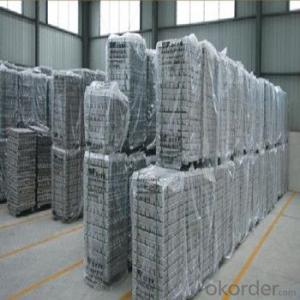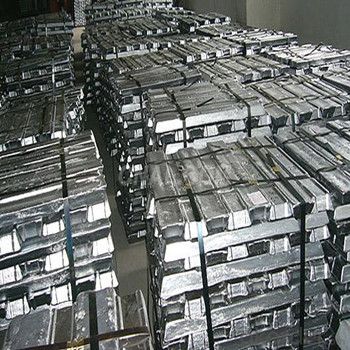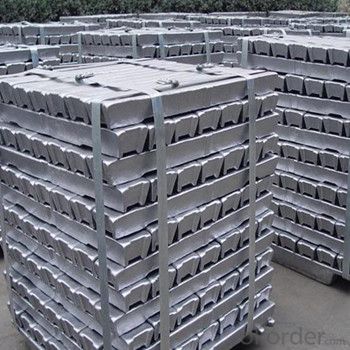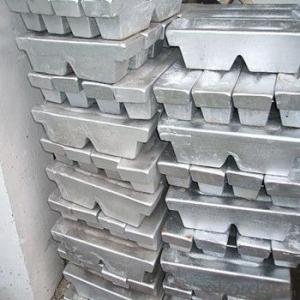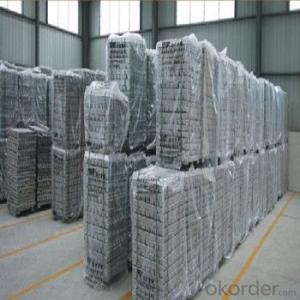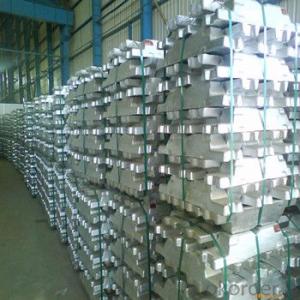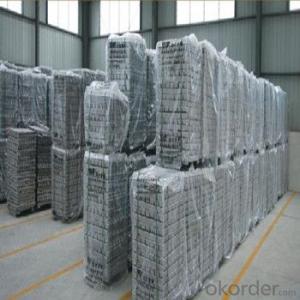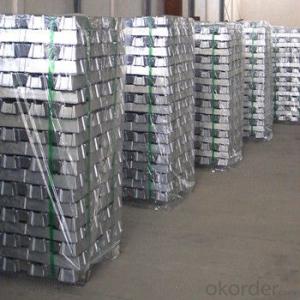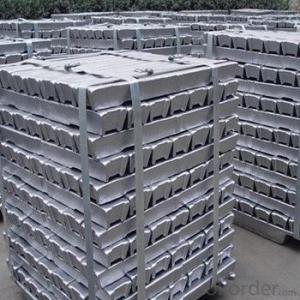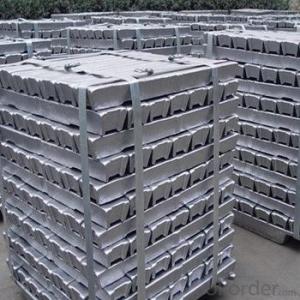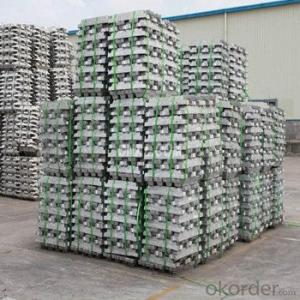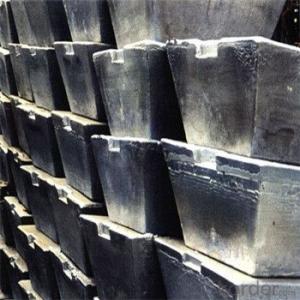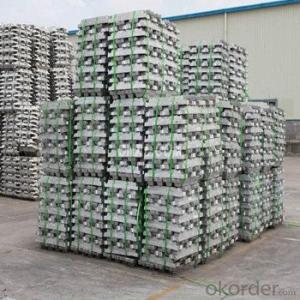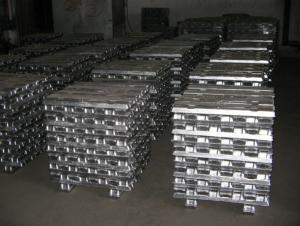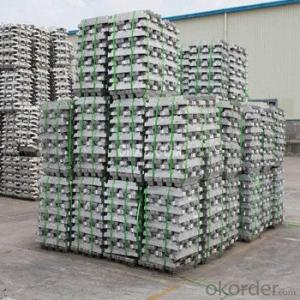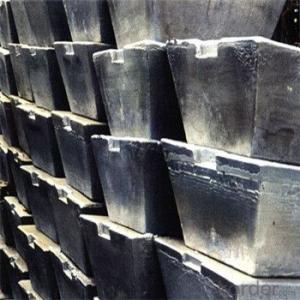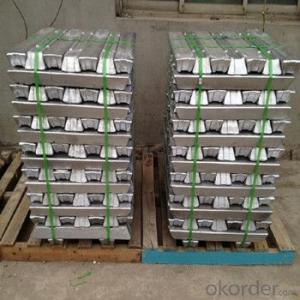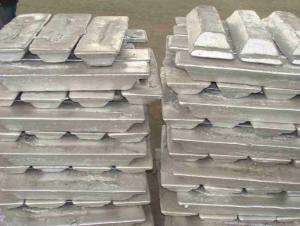Aluminum Pig/Ingot With High Purity And Different Grade
- Loading Port:
- China main port
- Payment Terms:
- TT OR LC
- Min Order Qty:
- 1000 m.t.
- Supply Capability:
- 100000 m.t./month
OKorder Service Pledge
OKorder Financial Service
You Might Also Like
Pure Aluminum Pig/Ingot Used for Industry
1.Structure of Aluminum Pig/Ingot
A material that has been cast into a shape in order to be transported and processed easier than in an unprocessed form. An ingot is typically rectangular in shape, which allows it to be stacked. Ingots are most commonly associated with metals, with ingots of gold held in the vaults of banks and brokerages being popular images.
Aluminum Ingot is with the AL as the main chemical composition.Aluminum Ingot is used for industry,such as automobile,pinning and weaving,electron broadly and so on. Aluminum Ingot has the following advantages: easy control and operation, fast melting.
2.Main Features of the Aluminum Pig/Ingot
•High Purity
•Easy control and operation
•High strength
•Fast melting
•Competitive price
•Best Service
3.Aluminum Pig/Ingot Images
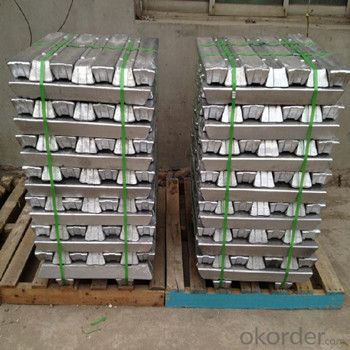
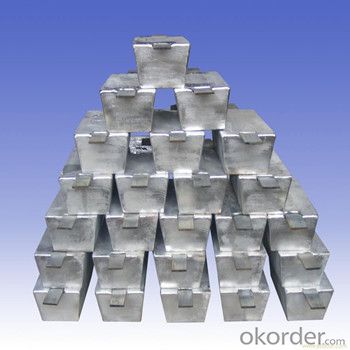
4.Aluminum Pig/Ingot Specification
Grade | Chemical Composition % | |||||||||
Al≥ | impurities ≤ | |||||||||
Si | Fe | Cu | Ga | Mg | Zn | Mn | others | Sum | ||
Al99.9 | 99.90 | 0.50 | 0.07 | 0.005 | 0.02 | 0.01 | 0.025 | - | 0.010 | 0.10 |
Al99.85 | 99.85 | 0.80 | 0.12 | 0.005 | 0.03 | 0.02 | 0.030 | - | 0.015 | 0.15 |
Al99.7 | 99.70 | 0.10 | 0.20 | 0.010 | 0.03 | 0.02 | 0.030 | - | 0.030 | 0.30 |
Al99.6 | 99.60 | 0.16 | 0.25 | 0.010 | 0.03 | 0.03 | 0.030 | - | 0.030 | 0.40 |
Al99.5 | 99.50 | 0.22 | 0.30 | 0.020 | 0.03 | 0.05 | 0.050 | - | 0.030 | 0.50 |
Al99.00 | 99.00 | 0.42 | 0.50 | 0.020 | 0.03 | 0.05 | 0.050 | - | 0.050 | 1.00 |
5.FAQ of Aluminum Pig/Ingot
We have organized several common questions for our clients,may help you sincerely:
①How about your company?
A reliable manufacturer & supplier of Aluminum Pig/Ingot,with many years’ experience in producing Aluminum Pig/Ingot.The items have beedn exported around the world,and have been acceptable among the customers,and have gotten the good reputation already.No matter from the quality,price and service,can be guaranteed for the cusgtomers.High purity and diffent grade are available.
②How to guarantee the quality of the products?
We have established the international advanced quality management system,every link from raw material to final product we have strict quality test;We resolutely put an end to unqualified products flowing into the market. At the same time, we will provide necessary follow-up service assurance.
③How long can we receive the product after purchase?
In the purchase of product within three wo We have organized several common questions for our clients,may help you sincerely:
- Q: What are the environmental impacts of producing aluminum ingots?
- The environmental impacts associated with the production of aluminum ingots are diverse. One major concern revolves around the extraction of bauxite, the primary ore used in aluminum production. The mining process, which often involves deforestation and habitat destruction, leads to the loss of biodiversity and disrupts ecosystems. Refining bauxite into alumina, a precursor to aluminum, demands significant amounts of energy. Typically, this energy is sourced from non-renewable fuels like coal or natural gas, resulting in greenhouse gas emissions and contributing to climate change. Subsequently, electrolysis is employed to convert alumina into aluminum metal, necessitating substantial electricity consumption. If this electricity is generated from fossil fuel-based power plants, it further exacerbates greenhouse gas emissions. Nevertheless, some aluminum smelters are transitioning to renewable energy sources, which aids in reducing their carbon footprint. The production of aluminum ingots also generates waste and by-products. The residue left after extracting alumina, known as red mud, possesses high alkalinity. If not properly managed, this residue can pose risks to soil and water quality and harm aquatic life if it enters nearby water bodies. Moreover, the transportation of bauxite, alumina, and aluminum ingots over long distances contributes to carbon emissions and air pollution. The extraction and production processes may also require the utilization of chemicals and other resources, which, if not properly managed, can have negative impacts on local ecosystems and water sources. In conclusion, the production of aluminum ingots entails various environmental impacts, including deforestation, greenhouse gas emissions, waste generation, and potential water and soil pollution. However, the industry is actively striving to address these concerns through the adoption of renewable energy, improved waste management practices, and resource efficiency measures.
- Q: How many tons of alumina for a ton of aluminum ingot, alumina and electrolytic aluminum what is the difference?
- Alumina is an oxide of aluminum, a compound, an element of aluminum.
- Q: How to refine aluminum ingot
- Sales must not be a big problem, small and medium-sized aluminum factories will generally buy, but if you do not remove other components, and direct sell cans, there is no big difference in price.
- Q: The mold is aluminum magnesium ingot foundry made it
- As for an iron mold shell, there is no high technical requirement, and the general casting method can be large, then it is better to V die
- Q: What are the environmental benefits of using aluminum ingots?
- Using aluminum ingots comes with several environmental advantages. Firstly, aluminum is highly recyclable and one of the most recycled materials worldwide. By utilizing aluminum ingots, we can foster a circular economy, where the material can be reused and repurposed without significant quality degradation. This reduces the necessity for extracting and processing new aluminum from bauxite ore, which consumes substantial energy and contributes to carbon emissions. The recycling of aluminum ingots significantly lessens the energy and carbon footprint associated with its production. Moreover, aluminum ingots possess a relatively low weight compared to alternative materials like steel. This lightweight characteristic proves advantageous in various industries, particularly automotive and aerospace. By employing aluminum ingots instead of heavier materials, vehicles and aircraft can attain better fuel efficiency, resulting in reduced greenhouse gas emissions. Additionally, the lightweight nature of aluminum ingots facilitates easier transportation and diminishes fuel consumption during the logistics process. Another environmental benefit of using aluminum ingots lies in their resistance to corrosion. Aluminum naturally forms a protective oxide layer, which prevents rust and degradation, making it highly durable and long-lasting. Consequently, products manufactured from aluminum ingots, such as building materials or consumer goods, enjoy an extended lifespan and require less frequent replacement. This reduces the overall demand for raw materials and minimizes waste generation. Lastly, aluminum ingots can contribute to energy savings in buildings. Aluminum serves as an excellent conductor of heat and electricity, permitting efficient thermal management in construction. By incorporating aluminum ingots into windows, doors, and other building components, energy consumption for heating and cooling can be decreased, leading to lower carbon emissions and reduced reliance on fossil fuels. In conclusion, the use of aluminum ingots offers environmental benefits, including recyclability, lightweight nature, corrosion resistance, and energy efficiency. By integrating aluminum ingots into various industries and products, we can promote sustainability, lower carbon emissions, and conserve natural resources.
- Q: What is the casting process for aluminum ingots?
- The casting process for aluminum ingots involves several steps to ensure the production of high-quality, uniform ingots. First, the raw aluminum is melted in a furnace at temperatures exceeding 660 degrees Celsius (1220 degrees Fahrenheit). The molten aluminum is then transferred to a holding furnace, where it is maintained at a consistent temperature to prevent solidification. Next, a mold is prepared for casting the aluminum ingots. The mold is typically made of steel or cast iron and is preheated to minimize thermal shock. The mold is also coated with a release agent to prevent the ingot from sticking to the mold. Once the mold is ready, the molten aluminum is poured into it. The pouring process can be done manually or using automated equipment, depending on the scale of production. The molten aluminum fills the mold, taking the shape of the desired ingot. After pouring, the mold is allowed to cool and solidify the aluminum. Cooling time varies depending on the size and thickness of the ingot. As the aluminum cools, it undergoes a phase transformation from liquid to solid, forming a solid ingot. Once the ingot is solidified, it is removed from the mold. This can be achieved by either manually removing the ingot or using mechanical means, such as vibrators or hydraulic presses, to eject the ingot from the mold. Finally, the ingots are typically subjected to further processing, such as heat treatment or surface finishing, to enhance their mechanical properties and appearance. These additional steps may include homogenizing the ingots to ensure uniformity, removing surface defects, or applying protective coatings. Overall, the casting process for aluminum ingots is a complex and precise operation that requires careful control of temperature, mold preparation, and post-processing steps to produce high-quality ingots suitable for further aluminum processing and applications.
- Q: How about aluminium material?
- Connaught scale is still OK, belong to cutting-edge, old trees send new shoots, they are from the aluminum out, the bird's nest is responsible for aluminum
- Q: Wall aluminum window price
- Now there are all aluminum furniture, aluminum materials, for more information, you can point me
- Q: What are the challenges in recycling scrap aluminum ingots?
- One of the challenges in recycling scrap aluminum ingots is the presence of impurities and contaminants. These impurities can affect the quality of the recycled aluminum and may require additional processing steps to remove them effectively. Additionally, the collection and sorting of scrap aluminum can be challenging due to its widespread use in various industries, leading to difficulties in sourcing sufficient quantities of clean and uncontaminated scrap material. Finally, the energy-intensive nature of aluminum production and recycling poses a challenge in terms of the environmental impact and cost-effectiveness of the recycling process.
- Q: Can aluminum ingots be welded?
- Yes, aluminum ingots can be welded. Welding is the process of joining two or more pieces of metal together by melting and fusing them. Aluminum, being a widely used metal, can be welded using various welding techniques such as TIG (Tungsten Inert Gas) welding, MIG (Metal Inert Gas) welding, and even spot welding. However, it is important to note that welding aluminum requires specific knowledge and techniques due to its unique properties. Aluminum has a high thermal conductivity and a low melting point, which makes it susceptible to warping and distortion during the welding process. Therefore, proper preparation, selection of appropriate welding equipment and techniques, and the use of specific aluminum welding electrodes or filler metals are crucial to achieve successful welding results.
Send your message to us
Aluminum Pig/Ingot With High Purity And Different Grade
- Loading Port:
- China main port
- Payment Terms:
- TT OR LC
- Min Order Qty:
- 1000 m.t.
- Supply Capability:
- 100000 m.t./month
OKorder Service Pledge
OKorder Financial Service
Similar products
Hot products
Hot Searches
Related keywords
